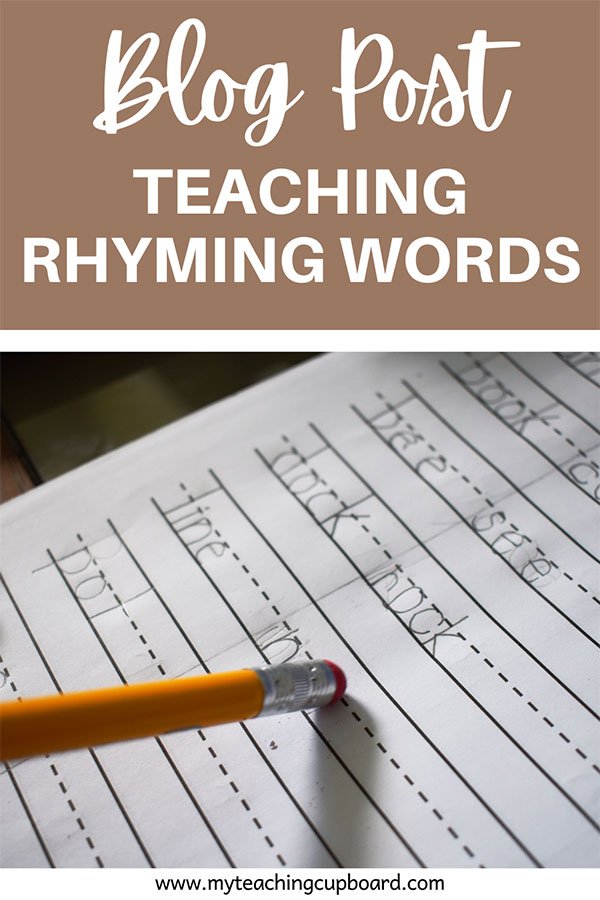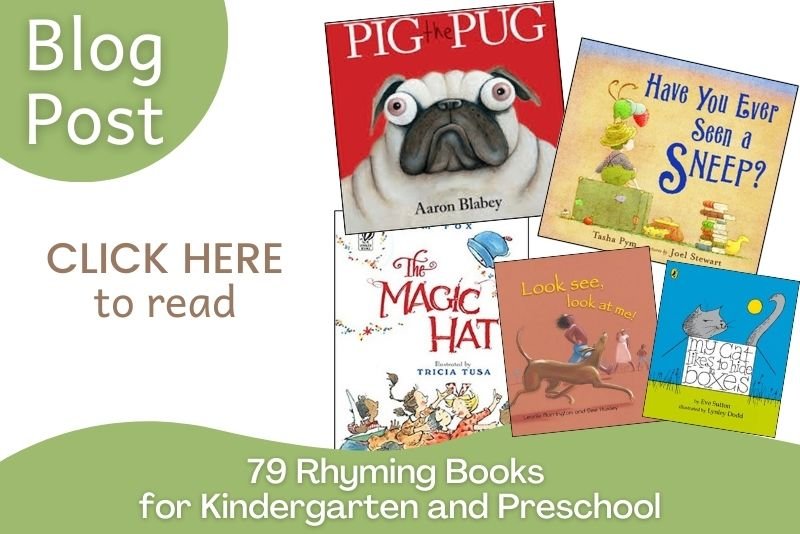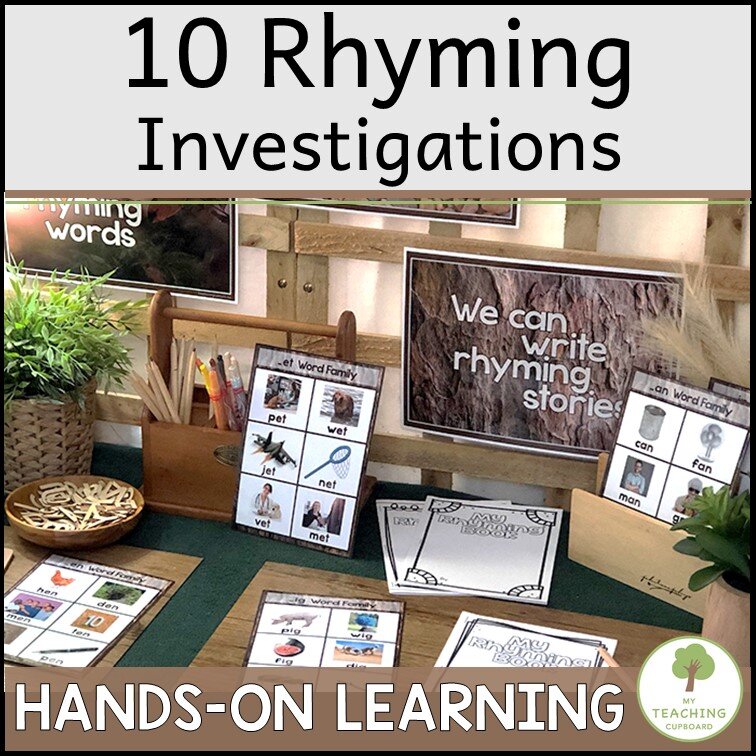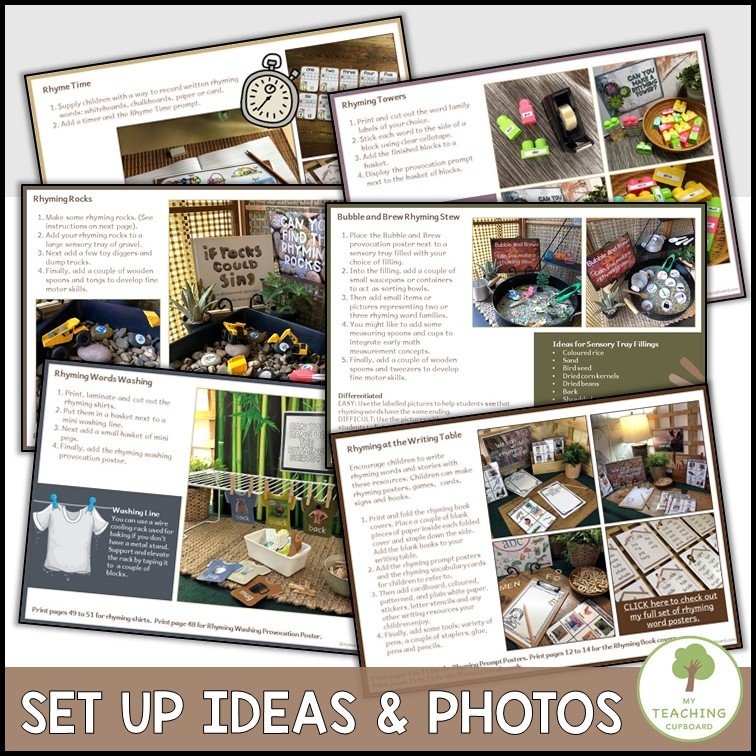Teaching Rhyming Words
Want some fun and effective strategies for teaching rhyming words to kindergarten and preschool kids? Make learning rhyming words a breeze with my engaging activities, rhyming games, and hands-on resources. Your students can master rhyming AND have fun doing it!
If you are an early childhood teacher, you need to be competent at teaching rhyming words. Rhyme is an important phonological awareness skill children must master in preschool and kindergarten because the ability to recognise, combine, and manipulate sounds in words forms the foundation of pre-reading and pre-writing. These are essential skills that should be incorporated into every early years literacy program.
Over the years, I’ve tried and tested many activities and lessons for teaching rhyme, but I always return to a few favourites. Why? Because they work.
My students love these activities because they're engaging, effective, and they consistently help kids learn to recognise, produce, and even write rhyming words.
Our literacy blocks are usually jam-packed and it’s difficult to fit another thing in so I decided to simplify my approach, focusing on just ten minutes a day of targeted instruction, complemented by a few dedicated rhyming investigation areas during investigation time and the results were astonishing.
In no time, my students were confidently identifying and generating rhymes, proving to me that it doesn’t take hours of instruction to make a significant impact.
If you’ve ever wondered why teaching rhyme is so important or how to effectively teach this skill to your students, this blog post is for you.
I’m sharing the tried-and-true strategies that have worked in my classroom and showing you how to incorporate some quick, engaging activities that will have your students mastering rhyming words with ease and confidence.
Why Teaching Rhyming Words is Essential
Learning about rhyming words is a foundational step in early literacy.
But what exactly are rhyming words?
A Simple Definition
Simply put, rhyming words are words that have the same ending sound, like cat and hat or dog and fog. The emphasis is on the sound, not the spelling, making rhyme an essential part of phonological awareness.
Rhyming plays a crucial role in developing phonological awareness, which is the ability to recognise and manipulate the sound structures of language. This skill is essential for young learners as they begin their journey toward reading and writing.
When children learn to recognise and produce rhyming words, they are actually developing the ability to hear and identify the similarities and differences in word sounds. This process develops their phonemic awareness, a critical subset of phonological awareness, which focuses on the smallest units of sound in words. For example, recognising that cat and hat rhyme because they share the same ending sound helps children understand that words are made up of distinct sound patterns.
But the benefits of teaching rhyming words extends beyond phonological awareness.
Rhyming also supports oral language development by expanding a child’s vocabulary and improving their ability to predict words and sentence patterns. This predictive skill is also a key component of reading comprehension, allowing children to anticipate what comes next in a sentence or story.
Rhyming lays the groundwork for spelling and written language. By recognising patterns in rhyming words, such as the -at in cat, hat, and bat, children begin to understand how letters and sounds work together, which helps them spell and decode new words.
Oh - and let’s not forget the element of fun and nonsense associated with rhyming. Rhyming activities often involve playful, nonsense words that engage children and make learning so enjoyable. This engagement is vital because when children are having fun, they are more invested in the learning process, leading to better retention and understanding.
Research consistently shows a direct correlation between learning to rhyme and eventual reading readiness. That’s why teaching rhyming words is such an integral part of every early years literacy program.
For a deeper understanding of how rhyming fits into the broader context of phonological awareness, including its relationship with syllables and phonemic awareness, you should explore my related blog post: Teaching Phonological Awareness and Phonemic Awareness In this blog post you’ll discover the developmental stages and heaps of practical teaching ideas and engaging activities to develop these important early literacy skills.
While you’re there, don’t forget to download my comprehensive FREE Guide to Phonological Awareness. I have devoted a section in this guide to teaching rhyming words so I think you’ll find it useful.
The Stages of Teaching Rhyming Words
Teaching rhyming words involves guiding students through a particular developmental sequence:
Identifying
Matching
Oddity
Producing rhymes
They are like building blocks - each stage builds upon the previous one, helping students develop a strong understanding of rhymes and their significance in language.
Let’s explore each stage in more detail and discover a fun and engaging activity that you can use to develop each stage with your students.
Stage 1: Identifying Rhymes
The first step in teaching rhyme is helping children identify rhyming words.
This involves listening carefully to word endings and recognising when two words sound the same. At this stage, the emphasis is on auditory discrimination—it's about helping your children hear rhymes and identifying the onset and rime.
Activity Example: Identifying Rhyming Words PowerPoint Activity
One effective tool for this stage is my Identifying Rhyming Words PowerPoint This interactive activity engages students as they learn to identify rhyming and non-rhyming words.
Each slide in my PowerPoint presentation features two real-life photographs. If the words rhyme, the children put their thumbs up; if they don’t rhyme, they put their thumbs down. The second slide in the sequence provides immediate feedback with a self-correcting answer, confirming whether the words share the same ending sound.
This PowerPoint includes:
12 sets of rhyming pictures
11 sets of non-rhyming pictures
56 slides in total, including introduction, self-correcting answer slides, and review summary slides
It’s perfect for whole class lessons, literacy warm-ups, assessments, or simply as a fun way to build phonemic awareness.
My students love the interactive nature of the activity, and I love how it reinforces the concept of rhyme in such an engaging way.
Stage 2: Matching Rhyming Words
Once children can identify rhyming words, the next step is to match them.
In this stage, you say a word and ask the students to choose another word that rhymes with it.
Matching rhyming words helps solidify their understanding of sound patterns and prepares them for more complex phonological tasks.
Activity Example: Rhyming Splat Game
A fantastic and super fun activity for matching rhyming words is my Rhyming Splat Game.
Here’s how it works:
Set Up: You’ll need some rhyming picture cards and two fly swats. Randomly place the rhyming pictures on a table where the children can see them.
How to Play: Two children each take a fly swat and sit around the table with the teacher. The teacher says a word that rhymes with one of the pictures on the table. The two children race to SPLAT the matching rhyming picture with their fly swat.
Winning: The child who splats the correct picture first keeps the fly swat for another turn, while the other child passes their fly swat to the next student. The game continues, giving every child a chance to participate and practice matching rhymes.
Download: This rhyming match game is so much fun! You can download the rhyming picture cards I use to play the Rhyming Splat Game for free HERE in my FREE Resource Library.
This game is not only fun but also highly effective in reinforcing the concept of rhyme. It encourages quick thinking, active listening, and helps students make connections between sounds and visual representations of words.
Stage 3: Rhyming Oddity
The third stage introduces the concept of oddity, where children identify the word that doesn’t belong in a group of rhyming words. For example, you might present the words hat, pig, and cat and ask, “Which one doesn’t rhyme?”
Activity Example: Prepare three objects or pictures, two of which rhyme and one that does not. Ask the students to identify the odd one out. This activity not only reinforces rhyming but also sharpens their ability to distinguish between similar and different sounds.
Stage 4: Producing Rhymes
The final stage is producing rhymes, where students generate their own rhyming words.
This stage is crucial for developing phonological awareness as it requires students to manipulate sounds and create new words that fit the rhyme pattern.
Activity Example: A simple and effective activity is to say a word and ask students to come up with as many rhymes as they can.
For instance, “Can you think of a word that rhymes with hat?” You don't have to just focus on real words either. Encourage your young children to be creative, even if they come up with silly or nonsense words—it’s all part of the fun and learning process.
In my classroom, I’ve found that dedicating just ten minutes a day to these types of rhyming activities, along with setting up a few rhyming investigation areas, can have a significant impact.
By breaking down the process into these manageable stages and using engaging tools like the Rhyming Splat Game, I’ve been able to help my students not only understand rhymes but also enjoy the whole process.
Quick and Easy Strategies for Teaching Rhyming Words
Teaching rhyming words doesn’t have to be a daunting task. With the right strategies, you can make it a fun and engaging experience for your students.
Here are some quick and easy strategies that will help your students master rhyming words while keeping engagement high.
Strategy 1: Use Word Family Anchor Charts
One of the most effective ways to teach rhyming words is by using word family anchor charts. These charts serve as a visual reference that helps students see the patterns in rhyming words.
Co-creating these posters with your students can be a particularly powerful learning experience.
Start by brainstorming a list of rhyming word family words together, such as cat, hat, and bat. Then, encourage the children to illustrate these words with their own hand-drawn artwork or pictures cut from magazines. This collaborative project not only reinforces the students’understanding of rhymes but also gives them a sense of ownership over their learning.
To save time, you can also use pre-made word family posters. My 55 Rhyming Word Family Posters are an excellent resource for this purpose.
They are designed to be used as both a classroom reference and a teaching tool, making them perfect for daily revision and practice.
These posters will help students focus on the fact that rhyming words share the same ending sounds and really solidify their understanding of word families.
Strategy 2: Read Aloud Rhyming Books
Reading aloud is one of the most powerful tools in your literacy arsenal, and adding rhyming books into your read-aloud sessions is an excellent way to expose children to rhyme in a meaningful and engaging way.
Rhyming books with rhythm and repetition are particularly effective because they not only capture children’s attention but also help them internalise the sound patterns of language.
Adding a rhyming book to your daily read-alouds can significantly boost your students’ ability to recognise and produce rhymes.
To help you get started, I’ve compiled a list of 79 Rhyming Books for Kindergarten and Preschool that are perfect for your classroom. These books cover a wide range of themes and styles, ensuring that there’s a rhyming story to capture the interest of every child.
Tips for Teaching Rhyming Words with Picture Books
Discuss the Rhymes: After reading a page, pause and ask the children to identify any rhyming words.
Pause for Predictions: Encourage children to predict the next rhyming word before you read it.
Point Out the Rhymes: Clearly state, “I hear rhyming words! Dog and fog rhyme.”
Brainstorm New Rhymes: Ask the children to come up with more words that rhyme with the ones in the book.
Interactive Listening: Have the children put their thumbs up each time they hear rhyming words.
Strategy 3: Incorporate Songs and Finger Plays
Songs and finger plays are another fantastic way to teach rhyming words. They provide a multi-sensory approach to learning and stimulate children’s senses of sight, hearing, and touch.
They often include movement too and we all know how important it is to get our little ones moving. A rhyming song or finger play makes a great brain break and also a wonderful hook for the beginning of your literacy lessons. It’s also beneficial for developing gross motor and fine motor skills, coordination, and body awareness.
Rhyming songs and finger plays not only engage children but also build vocabulary and speech skills. As they sing and play, children naturally learn about the sounds of spoken words and the rhythm of language.
Some of my favourite songs for teaching rhyme include classics like “Twinkle, Twinkle, Little Star” and “Down by the Bay,” where the rhyming patterns are both clear and memorable.
Strategy 4: Use Nursery Rhymes and Short Poems
Nursery rhymes and short poems are timeless favourites in the early years classroom and excellent tools for teaching rhyming words.
These simple, rhythmic verses are not only enjoyable for children but also incredibly effective for teaching the rhythm and patterns of language. Integrating nursery rhymes into your literacy blocks or play-based activities will develop your students’ understanding of rhyme.
Tips for Teaching Rhyming with Nursery Rhymes
Create Class Reading Books: Turn nursery rhymes into class books that students can read and enjoy during independent reading time.
Innovate Together: Change a few words in the rhyme to create a new version (e.g., “Humpty Dumpty sat on a rock, Humpty Dumpty got a big shock”).
Add to Learning Provocations: Use nursery rhymes as prompts for creative and open-ended play activities.
If you’re interested in using nursery rhymes to teach rhyming words, you might like my Nursery Rhyme Playdough Mats.
I designed them for teaching word awareness but they could also be a great hands-on resource for students learning rhyming words too.
By implementing these quick and easy strategies into your daily teaching routine, you’ll help your students develop a strong understanding of rhyming words, setting them up for success in reading and writing.
And the best part? These activities are not only effective but also loads of fun!
Rhyming Games and Play-Based Learning
You can make rhyming words come alive through play!
I have found one of the most effective ways to teach rhyming words is through play based learning and investigative activities.
When learning becomes a fun, interactive experience, children are more engaged and motivated, leading to better retention and understanding. Please use rhyming games and hands-on rhyming activities in your classroom if you want to reinforce phonological awareness, teach rhyme and foster a love for language.
Using Fun Name Games
One of my favourite rhyming activities involves using the children’s names. There’s something magical about incorporating a child’s own name into a game. It immediately captures their attention and makes the learning experience personal and memorable.
Here’s how it works: I start by saying a phrase like, “It starts with /b/ and ends with /en/... put them together and it says…” The children excitedly shout out “Ben!”
This simple name rhymes game is not only fun but also highly effective in helping children understand how sounds come together to form words that rhyme. It’s a great way to start the day or to use as a warm-up or quick transition activity between lessons.
Integrating Rhyming into Literacy Investigation Areas
In addition to structured games, adding rhyming provocations to your literacy centres or investigation areas can have a profound impact on your students’ learning.
I’ve found that when children have the opportunity to explore rhymes through hands-on activities they internalise these concepts more deeply. It's the best way to make learning rhyming words fun and purposeful.
For example, setting up a rhyming investigation area with picture cards, small objects, and matching games allows children to independently practice their rhyming skills in a playful and self-directed manner. This approach encourages curiosity and reinforces learning without the pressure of formal instruction.
If you’re looking for resources to support the various activities in this kind of play-based learning, my Educational Hands-On Rhyming Activities pack is a good start.
This selection of activities have been designed to help you create engaging and effective rhyming centres. They are perfect for literacy learning centres or investigation areas, where children can explore rhyming words in a fun, hands-on way.
There are 10 educational hands-on rhyming activities for young students to learn and revise word families and rhyming words through play based learning in this delightful rhyming pack. Perfect for investigation areas or literacy learning centers.
Children will read and write rhyming words, revise word families, see that rhyming words have the same ending and listen for the rhyme in words.
There are sensory tray ideas, provocation posters, ideas for your math, literacy, atelier, play dough play spaces and so much more in this comprehensive early years literacy provocations pack.
Each provocation includes handy tips and ideas for setting up engaging investigation areas along with detailed photographs to ensure your Word Family and Rhyming learning areas and activities are quick and easy to prep and set up.
The Importance of Regular, Playful Practice
Lots of practice is the secret to mastering any new skill, and rhyming is no exception. By making rhyming a regular part of your classroom activities—whether through games, read-alouds, or investigation areas—you give your students the repetition they need to become confident in their ability to recognise and produce rhymes.
Play based learning activities designed to teach rhyming words are particularly powerful because they transform learning into something children really look forward to.
When rhyming activities are fun, children are more likely to engage with them frequently and enthusiastically. This consistent exposure helps to solidify their understanding and makes rhyming a natural part of their language development.
Add any of these rhyming games and activities to your classroom routines and you’ll not only enhance your students’ phonological awareness but also create a classroom environment where learning is synonymous with fun.
With the right tools and a playful approach, you’ll see your students’ rhyming skills flourish in no time!
Overcoming Common Challenges in Teaching Rhyming Words
Teaching rhyming words can sometimes feel like an uphill battle, especially when you encounter common challenges that can slow down progress.
Whether it’s a student who struggles with producing rhymes or a group that finds it difficult to recognise rhyming patterns, these obstacles can be frustrating. However, with the right strategies, you can overcome these challenges and help all your students succeed.
Students Struggling with Rhyme Production?
One of the most common issues I’ve had is students who struggle to produce rhymes. These students may be able to recognise rhyming words when they hear them, but when asked to generate a word that rhymes with cat, they stare at you blankly or offer some obscure response.
Ever had a student respond with “meow” when asked to produce a word to rhyme with cat? I have!
Solution: To help students overcome this hurdle and actually produce the correct answer, start by breaking down the task into smaller, more manageable steps. A great idea is to begin with easier rhyming tasks that focus on auditory discrimination, such as identifying rhymes in songs or stories.
Gradually increase the difficulty by introducing word families and using visual aids like my word family posters.
Another effective strategy is to provide more guided practice through games like the Rhyming Splat Game mentioned earlier. This game helps students practice matching rhyming words in a fun and engaging way, which can build their confidence in rhyme production.
Also consider integrating more hands-on, playful activities like the ones in my 10 Educational Hands-On Rhyming Activities Pack. These highly engaging activities are designed to reinforce rhyming skills through interactive learning.
Students with Difficulty in Recognising Rhyming Patterns?
Some students may find it challenging to recognise rhyming patterns, especially when the words don’t look similar in spelling but sound alike (e.g., bear and hair). This confusion can hinder their ability to identify and match written rhyming words accurately.
Solution: To address this issue, focus on activities that emphasise listening skills rather than visual cues. After all, rhyming as a phonological awareness skill is all about hearing and speaking. Phonological awareness does not involve written words – that’s phonics!
For example, use the Identifying Rhyming Words PowerPoint Activity to practice distinguishing rhyming pairs based solely on sound. This activity removes the distraction of spelling and helps students tune into the auditory patterns that define rhymes.
You might even need to take a step back and work on general auditory discrimination skills. If that’s the case, you will find my Guess the Animal Sound PowerPoint Game or my Guess the Sound Listening Activity for Auditory Discrimination ideal.
You can also add more read-aloud sessions to your day. Make sure they feature rhyming books. Pausing to discuss and predict rhyming words during the story will reinforce the idea that rhymes are about sound, not spelling. Over time, students will become more adept at recognising rhyming patterns, even when the words look different.
Limited Time for Intensive Rhyming Practice?
Another challenge is finding enough time in a busy schedule to dedicate to rhyming instruction, especially for students who need more intensive practice.
It’s not always feasible to spend large portions of your literacy block on rhyming activities. You really don't need to devote a lot of time to this early literacy skill.
Solution: If you are struggling to fit rhyming practice into your lesson plans, I've got an idea!
To make the most of your time, integrate rhyming practice into other areas of the curriculum through investigation areas and playful learning centres. Setting up dedicated rhyming stations allows students to practice rhyming during investigations, group rotations or even transitions, ensuring they get the practice they need without requiring additional instructional time.
For students who need more focused intervention, my blog post 43 Rhyming Activities for Kindergarten has a wealth of ideas for hands-on, intensive rhyming practice.
With this many activities, there’s plenty to choose from and they are all specifically designed to be both effective and engaging.
They are perfect for small group work or individual practice.
By anticipating and addressing these common challenges, you can create a classroom environment where all students have the opportunity to succeed with rhyming words. With a combination of targeted strategies, playful learning, and the right resources, you’ll be well-equipped to overcome any obstacles that arise and help your students build a strong foundation in phonological awareness.
In Conclusion
Teaching rhyming words is an important component of phonological awareness and an integral part of early literacy but it doesn’t have to be overwhelming. By using a mix of quick and easy daily strategies, engaging hands-on activities, and playful learning opportunities, you can help your students master this essential skill with confidence.
Whether it’s through interactive games, rhyming books, or hands-on investigation areas, each approach plays a vital role in developing your students’ phonological awareness and setting them up for reading and writing success.
Ready to enhance your rhyming instruction? Explore my comprehensive resources and activities designed to make teaching rhyme both effective and fun.
From word family posters to engaging games and comprehensive blog posts, I’ve got you covered with everything you need for teaching rhyming words.
If you liked this post on teaching rhyming words, please consider sharing it.
Just CLICK the sharing box below.👇




















